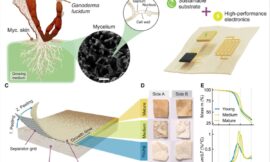An international team of scientists has discovered an exoplanet with anomalous characteristics in the so-called ‘Neptunian desert’, an area very close to the host star where planets of sizes between Earth and Jupiter hardly appear. Its name is TOI-849b and it could be the nucleus of an ancient gas giant stripped of its gas envelope. It is the first detection of the naked core of a gas giant.
The interior of the gas giant planets is still a mystery to researchers. Even for the planets in the solar system, the study of their nuclei is extremely complicated due to observational difficulties. In this context, exoplanets that appear to have undergone anomalous evolutionary processes provide scientists with a new avenue to understand planetary interiors.
Within this type of planets are those found in the so-called ‘ Neptunian desert ‘, a name given to the shortage of size planets between Earth and Jupiter that are discovered orbiting very close to their host star.
Among the few cases detected, these are unusually dense planets , suggesting that they have undergone processes of atmospheric erosion due to high radiation from their host star that has partially removed their outer atmosphere. They are believed to be so rare because most of them end up evaporating in just a few billion years.
In a study published today in the journal Nature , a scientific team led by researcher David Armstrong from the University of Warwick (United Kingdom) and involving members of the Center for Astrobiology (CAB , CSIC-INTA), announces the discovery of one of these anomalous exoplanets, named TOI-849b .
The finding was made by NASA’s TESS (Transiting Exoplanet Survey Satellite), and confirmed with the HARS instrument from the European Southern Observatory (ESO) in La Silla (Chile).
Anomalous characteristics
The exoplanet orbits a TOI-849 solar-type star, which is about 730 light years from Earth . Its radius, about 3.5 times greater than that of Earth , indicated that it was a gaseous planet similar to Neptune and Uranus. However, measuring its mass with the HARPS instrument produced an unusually large mass , about 40 times greater than that of Earth (Neptune’s mass is about 16 times greater than that of Earth).
The radius and mass values of TOI-849b indicate that its density is similar to that of Earth, making it a gigantic solid planet, the largest one found to date, containing, at most, 3% of its mass as a gaseous atmosphere.
With these peculiar characteristics, the main hypothesis of the researchers is that we are facing the bare core of what was a gas giant like Jupiter, but that has evaporated all its gas envelope.
To explain this immense loss of mass, the researchers propose several scenarios . In one of them, the planet initially formed as a gas giant away from its star, then migrated inland and got so close to its star that the tidal effects eliminated the atmosphere.
Another possibility is a large planetary collision with another planet in the system. It could also be that TOI-849b was a failed giant: after the formation of its nucleus, something could happen in the system that prevented the planet from continuing to accumulate the gas necessary to form its atmosphere.
But are these the only possibilities? One of the tasks of the CAB co-authors has been, precisely, to rule out other possible scenarios. In particular, in the context of the TROY project , led by CAB researcher Jorge Lillo-Box , the possibility that the wobble of the star with which the planet’s mass has been measured was not caused by one but by two planets located in the same orbit, which are known as co-orbital planets.
A bare rocky core
As Lillo-Box points out, “the analysis performed allowed us to rule out the presence of planets co-orbiting with TOI-849b with a mass greater than eight Earth masses. These results have definitively ruled out the coorbital scenario as the source of the planet’s great mass, thus confirming the hypothesis that TOI-849b is definitely a bare rocky core, probably a gigantic sphere composed mainly of iron and silicates . ”
TOI-849b represents, therefore, a unique case where the material of the primordial nucleus of the formation of a gas-type planet can be studied. According to the authors, this discovery will allow a better understanding of the internal structure and formation of gas giants.
n any case, the origin of this strange planet has yet to be determined and future observations will be necessary to elucidate its origin.
The European Space Agency plans to launch a mission similar to TESS, but much more ambitious and in which the National Institute of Aerospace Technology (INTA) and the CAB, along with other Spanish institutions such as the Institute of Astrophysics of Andalusia, the University of Granada and the Canary Islands Institute of Astrophysics have a very important role.
This is the PLATO satellite , currently under development. Its mission is to detect and characterize terrestrial-type planets in orbits around stars similar to the Sun. It is at a crucial moment in its design and implementation and, according to its promoters, requires the determined support of the State Research Agency and the Spanish Center for Technological Development.
For David Barrado , a CAB researcher involved in this study, “the results of the TESS satellite, as illustrated by the case of TOI-849b, show that a determined and consistent investment over time produces significant advances in our knowledge of the reality of the universe and our role in it.”

